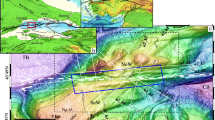Abstract
Many shallow water, fine-grained sediments apparently contain appreciable quantities of interstitial gas bubbles produced by the biochemical degradation of organic matter. There have been relatively few direct observations of entrapped bubbles, but the presence of extensive gaseous sedimentary zones has frequently been inferred from high resolution sub-bottom profiling records. Frequently, large segments of many records made in estuaries and bays with high-frequency, low-energy profilers are confused and characterized by bands of strong diffuse reflection that mask the underlying features. Investigators have repeatedly attributed this anomalous acoustic behavior to the presence of interstitial gas bubbles, which produce excessive reverberation of sound within the sediment. Until recently, however, this hypothesis for the explanation of the acoustically impenetrable or ‘turbid’ character of sediments had apparently not been tested.
Acoustically ‘turbid sediments’ cover large areas of Chesapeake Bay. Along a cross-section parallel to the Bay Bridge near Annapolis, acoustically turbid zones alternate with zones where good sub-bottom records can be obtained. The sediments are quite similar in grain size, mineralogy, and water content. Determinations of the compressibility of sediment samples from the acoustically turbid zones, and from contiguous zones where good sub-bottom records were obtained, showed that the acoustically turbid sediments are several orders of magnitude more compressible than the acoustically clear sediments. The increased compressibility is a result of the presence of interstitial gas bubbles. X-ray examination of frozen cores confirmed this. Bubbles were scarce or absent in cores from acoustically clear areas. Although the acoustically turbid zones are of considerable horizontal extent, their vertical dimensions may be only 1 to 3 meters.
The cause of the acoustically turbid character of some other zones in Chesapeake Bay is buried shell beds (bars). The compressibility of sediments from these areas is not anomalously high. The two kinds of acoustically turbid zones can normally be distinguished by a careful examination of the sub-bottom profiling records.
High resolution sub-bottom profilers can be used to map the distribution of gas bubble zones, and for the selection of coring stations for gas analysis.
Access this chapter
Tax calculation will be finalised at checkout
Purchases are for personal use only
Preview
Unable to display preview. Download preview PDF.
Similar content being viewed by others
References
Anderson, A. L., T. G. Muir, R. S. Adair, and W. H. Tolbert, A geoacoustic study of the Brazos River, Part I, Environ. Studies, Defense Res. Lab. Tech. Rep. No. A-294 (DRL-A-294), Univ. of Texas at Austin, 1968.
Bobber, R. J., Acoustic characteristics of a Florida lake bottom, J. Acoust. Soc. Amer., 31, 250, 1959.
Emery, K. O., A Coastal Pond Studied by Oceanographic Methods, 80 pp., Elsevier Pub. Co., New York, 1969.
Grim, M. S., C. L. Drake, and J. R. Heirtzler, Sub-bottom study of Long Island Sound, Geol. Soc. Amer., Bull., 81, 649, 1970.
Hampton, L. D., Acoustic properties of sediments, Defense Res. Lab. Acoustic Rep. 254 (DRL-A-254); Univ. of Texas, 1966.
Jones, J. L., C. B. Leslie, and L. E. Barton, Acoustic characteristics of a lake bottom, J. Acoust. Soc. Amer., 30, 142, 1958.
Jones, J. L., C. B. Leslie, and L. E. Barton, Acoustic characteristics of underwater bottoms, J. Acoust. Soc. Amer., 36, 154, 1964.
Klein, M. and H. E. Edgerton, Sonar—a modern technique for ocean exploration, Inst. Elect. Electron. Eng. Spectrum, 5, 40, 1968.
Levin, F. K., The seismic properties of Lake Maracaibo, Geophysics 27, 35, 1962.
Moody, D. W., and E. D. van Reenan, High-resolution subbottom seismic-profiles of the Delaware Estuary and Bay mouth, U. S. Geol. Survey Prof. Paper 575-D, D247, 1967.
Nyborg, W. L., I. Rudnick, and H. K. Schilling, Experiments of acoustic absorption in sand and soil, J. Acoust. Soc. Amer. 22, 422, 1950.
Reeburgh, W. S., Observations of gases in Chesapeake Bay sediments, Limnol. and Oceanogr., 14, 368, 1969.
Schubel, J. R., and E. W. Schiemer, The origin of acoustically turbid sediments in Chesapeake Bay, Spec. Rep. 23, Ref. 72–5, 21 pp., Chesapeake Bay Inst, of The Johns Hopkins University, 1972.
Schubel, J. R., and C. F. Zabawa, A Pleistocene Susquehanna River channel connects the lower reaches of the Chester, Miles, and Choptank Estuaries, Spec. Rep. 24, Ref. 72–8, 12 pp., Chesapeake Bay Inst, of The Johns Hopkins University, 1972.
Schubel, J. R., and E. W. Schiemer, The cause of the acoustically impenetrable, or turbid, character of Chesapeake Bay sediments, Mar. Geophys. Res., in press, 1973.
Skempton, A. W., Effective stress in soils, concrete, and rocks, in Intern. Soc. of Soil Mechanics and Found. Eng., British Bat. Soc., Pore Pressure and Suction in Soils, Butterworths, London, 1961.
Stiles, N. T., Isopachous mapping of the lower Patuxent Estuary sediments by continuous seismic profiling techniques, U. S. Naval Oceanogr. Office Informal Rep. No. 37, 26 pp., 1970.
Stiles, N. T., L. R. Breslau, and M. D. Beeston, The riverbed roughness and sub-bottom structure of the main shipping channel to Sai Gon, RVN (Nga Bay, Long Tau, Nha Be, and Sai Gon Rivers), Proc 12th Conf. on the Naval Minefield, Naval Ordnance Lab. Tech. Rep. 69–69, 1, 327, 1969.
Wood, A. B., A Textbook of Sound, 578 pp., MacMillan Co., New York, 1941.
Wood, A. B., and D. E. Weston, The propagation of sound in mud, Acustica, 14, 156, 1964.
Author information
Authors and Affiliations
Editor information
Editors and Affiliations
Rights and permissions
Copyright information
© 1974 Plenum Press, New York
About this chapter
Cite this chapter
Schubel, J.R. (1974). Gas Bubbles and the Acoustically Impenetrable, or Turbid, Character of Some Estuarine Sediments. In: Kaplan, I.R. (eds) Natural Gases in Marine Sediments. Marine Science, vol 3. Springer, Boston, MA. https://doi.org/10.1007/978-1-4684-2757-8_16
Download citation
DOI: https://doi.org/10.1007/978-1-4684-2757-8_16
Publisher Name: Springer, Boston, MA
Print ISBN: 978-1-4684-2759-2
Online ISBN: 978-1-4684-2757-8
eBook Packages: Springer Book Archive



